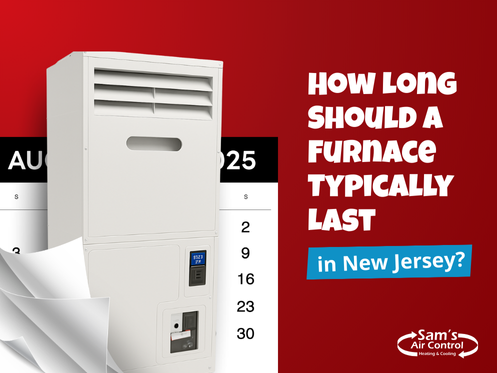When temperatures drop during a New Jersey winter, you rely on a furnace to keep your home warm and comfortable. But furnaces don’t last forever, and knowing the signs of their failure and how long a furnace should last can help you plan for maintenance, repairs, and eventual replacement. In this guide from SAM’s Air Control, we will go through the different types of furnaces and the factors that affect their lifespans.
Average Furnace Lifespan Explained
New Jersey’s shifting weather patterns, from humid summers to cold winters, can impact how hard your furnace works throughout the year. With proper maintenance, care and upkeep, a furnace can last anywhere from 15 to 30 years in New Jersey. This range represents the sweet spot for a furnace’s consistent heating use and its efficiency. Electric furnaces typically last longer than gas furnaces. There are a few factors that can shorten or lengthen the lifespan of a furnace:
- Brand of furnace: Some manufacturers produce much higher-quality, more durable units that last longer than other brands
- Quality of install: A furnace that was properly sized for your home and installed by qualified technicians will generally last longer than one that wasn’t. Oversized units tend to short cycle.
- Regular maintenance: Units that have annual professional tune-ups, regular filter changes, and prompt repairs to minor issues will reach or even exceed their lifespan.
- Climate: The state of New Jersey’s moderate climate means furnaces don’t run as constantly as they might in extremely cold regions, but the humidity levels and seasonal temperature swings still create challenges for a furnace.
Read up on the best ways to maintain your HVAC unit before the colder seasons here.
Gas Furnace Life Expectancy
With the availability and relatively stable cost of natural gas in New Jersey, a gas furnace is the common choice for homeowners. Its life expectancy falls somewhere in the 15 to 20-year range.
Modern high-efficiency gas furnaces often incorporate advanced features like variable-speed blowers, modulating gas valves, and sophisticated, customizable control systems. These components can extend the unit’s lifespan by reducing stress on the system and allowing it to operate more smoothly. Still, with these new features, more maintenance may be needed than with older models.
The heat exchangers in modern gas furnaces are more durable and less prone to cracking, which is one of the most serious and common failure points in gas heating systems.
How Long Does an Electric Furnace Last?
An electric furnace lasts longer than a gas furnace, with a lifespan of 20-30 years. There are fewer moving parts, but an electric furnace can be more expensive in terms of energy bills. This is where HVAC efficiency is key. When shopping around for a new replacement furnace, look for a symbol like the ENERGY STAR logo to determine its efficiency. Read up on another mark of efficiency, the annual fuel utilization efficiency (AFUE) ratings here. For example, a 90 AFUE furnace is more efficient than an 80.
Electric furnaces do have some parts that wear out over time, like the heating elements, blower motors, and electrical connections. The good news is that these parts are typically less expensive to replace than major components in gas furnaces.
How the Type of Furnace You Choose Impacts Life Expectancy
The specific type and quality of furnace you select will significantly influence how it works for your home. Single-stage furnaces, which operate at full capacity whenever they run, typically last 15 to 20 years. They only need to run about 15-20 minutes, but because of fluctuating temperatures, they usually need to run two to three times an hour. These simpler systems have fewer complex components and are cheaper to install, but may experience more wear from frequent on-off cycling.
Two-stage and modulating furnaces often provide longer service lives because they can operate at lower capacities most of the time, reducing stress on components. These systems may last 20 to 25 years or more, but the advanced technology means installation and repair costs may be higher when problems do arise. Two-stage and modulating furnaces have a major advantage, as they’ll keep every room consistently warm while using less energy to do so.
The average cost for a furnace in New Jersey is $3000 – $7000, with factors like brands, size, efficiency rating, and installation complexity affecting the cost.
Signs It’s Time for Furnace Replacement in NJ
There are many warning signs that your furnace is reaching the end of its lifespan:
- Age of unit: If your unit is reaching that 15-20 year mark, it is most likely not running as efficiently as it once did.
- Inconsistent heating: Uneven heating throughout your home may indicate that your furnace can no longer distribute heated air effectively.
- Rising energy bills: If you have noticed a spike in your energy bills and haven’t changed any daily energy habits, this could mean your furnace is struggling, working harder, and becoming less efficient.
- Frequent repairs and the 50% rule: If you are having to repair your furnace once or twice annually, it’s time to think about a new unit. Also, if you’re facing repairs that are 50% the price of your furnace, it’s more economical to replace the unit.
- Strange noises and smells: Banging, clicking, clanking, or hissing noises signal your furnace could be on its last legs. Musty or burning smells shouldn’t be ignored.
Recognizing these signs will help you get the most value from your heating investment. When the time comes for a furnace replacement, choosing a quality system and having it properly installed will set the stage for many years of comfortable, efficient heating in your New Jersey home.
How to Extend the Life of Any Furnace
Regular maintenance is the most effective way to maximize your furnace’s lifespan.
- Schedule professional tune-ups: Annually, ideally before the heating season begins. During these service calls, technicians will clean components, check for wear, lubricate moving parts, and identify potential problems before they become major issues.
- Changing your furnace filters: Doing this regularly is the simplest yet most important maintenance task you can perform yourself. A clean filter allows proper airflow, reduces strain on the blower motor, and helps maintain indoor air quality. Most filters should be changed every one to three months.
- Keep the furnace area clean: If you see any debris or dust accumulating, make sure to clean it. This also helps reduce a frisk risk.
- Upgrade your thermostat: A smart thermostat is customizable and helps maintain a consistent temperature and prevent short cycling.
Call SAM’s Air Control for Any Furnace Needs
Whether your furnace is approaching its expected lifespan or you’re experiencing performance issues, SAM’s Air is here to help. Our experienced technicians provide comprehensive furnace maintenance, reliable repairs, and professional installation services throughout New Jersey, including areas like Metuchen, Woodbridge, and Clark. Don’t wait until your heating system fails during the coldest days of winter. Contact SAM’s Air today to schedule a furnace inspection or to discuss replacement options.


